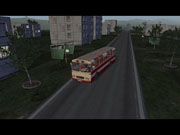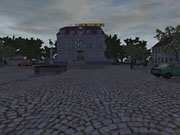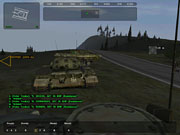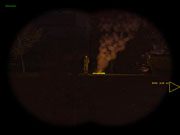Some tactical shooters skimp on story and atmosphere, instead giving you piles of real-world weapons and gear, hoping that alone will suffice to hold your interest. Not Bohemia Interactive's Operation Flashpoint: Cold War Crisis, which generated a big buzz in the shooter community and earned lots of critical praise and awards when it was released last year. Operation Flashpoint let you play as an individual soldier, but it also let you command other troops, drive trucks and tanks, fly attack helicopters, and much more. It included dozens of interesting missions and a powerful mission editor. Just as importantly, it took great advantage of the scene-setting and storytelling techniques found in the best traditional single-player shooters, creating a memorable fictional world. Sometimes Operation Flashpoint's attempts at immersing you in that world fell flat, but the game definitely earned an "A" for effort. That same dual focus on immersion and complex military action returns in force with Operation Flashpoint: Resistance, a large and entertaining expansion pack for the original game.

Operation Flashpoint already received one expansion pack of sorts, the Red Hammer campaign found in the Gold and Gold Upgrade editions of the game. Unlike the Red Hammer campaign, Resistance goes further than simply adding new missions. Requiring the original Operation Flashpoint to play, Resistance incorporates all the patches so far released for the original game and also includes a number of other significant upgrades. The visuals have been improved, and the multiplayer code that caused problems for more than a few people has been tweaked, too. You also get a new 20-mission campaign, five stand-alone missions, nine multiplayer missions, new vehicles, new weapons, and a huge new island on which to battle.
As with Operation Flashpoint, an interesting story ties the game's combat encounters together. Resistance plays out a few years before the story of Operation Flashpoint, letting you assume the role of Victor Troska, a former Special Forces soldier. Having grown weary of fighting, Troska retires to the sleepy, provincial island of Nogova, a fictional area that readily calls to mind the Balkans. The sympathetic Troska's peace and quiet don't last long. A split between hard-line Communists and reformers causes Nogova's government to collapse, whereupon Soviet forces led by a brutal commander arrive to establish a puppet government. Only Troska is capable of organizing and leading a militia resistance.
The story is told through the same kind of lengthy in-engine cutscenes that were hallmarks of Operation Flashpoint. The extensive opening sequence, for instance, introduces you to Victor's quiet, cozy life and the tranquil simplicity of Nogova. This makes it all the more dramatic when the Soviets rush in, guns blazing. While Resistance deserves credit for taking such a cinematic approach and often succeeding, some problems mar the storytelling. Sometimes the cutscene direction can look pretty clumsy or resort to hoary clichés like focusing on a sped-up clock to indicate the passage of time. The cutscenes also suffer from long load times, and the scenes themselves can be overly lengthy to the point of tedium.
Still, the storytelling works well overall, thanks to some dramatic twists and bloody surprises, as well as some tough decisions you have to make. Early in the game, for example, you'll have to decide whether to betray a partisan fighting against the Soviets--doing so might save some friends from imminent execution. Do you reveal the partisan's location, try to talk your way out of the jam, or run for a gun?

Even outside these sorts of dramatic turning points, your decisions will often carry over from one mission to another. Since you end up leading a ragtag militia of ex-soldiers and simple country folk, weapons and reinforcements will be in very short supply. You'll need to scavenge gear and, more daringly, steal tanks and other vehicles from the enemy, all while treating your men as irreplaceable assets and not simple cannon fodder. All at once, this adds realism, heightened drama, and some interesting tactical decisions to the game. Do you spend precious time collecting weapons from dead enemies to stash for later use, or do you leave the weapons and flee before more enemies arrive?
If you don't find or bring along the right weapons during a mission or if you lose too many men, you'll need to restart earlier in the campaign to have a chance of success. On the other hand, you'll sometimes spend time filling crates or trucks with all the guns and ammo you can scavenge, only to find to your dismay that none of them are accessible in the next mission, after all. Making things even tougher, your comrades aren't particularly bright, so preserving your men can be more difficult than necessary. (For that matter, AI pathfinding remains an intermittent problem, too.)

You'll find a lot of interesting variety in Resistance's missions. You'll flee across the countryside in a stolen truck while being pursued by the Soviets, defend against ambushes, attack convoys, assault bases, and more. Most of the missions offer fun and sophisticated challenges, though some are much too tough (why do Troska and his tiny band often pick the biggest, toughest targets?), and you get only one elective save per mission. As in Operation Flashpoint, some missions seem to suffer from scripting bugs that prevent the mission from playing out properly. Some of the missions are poorly paced, too, requiring you to use the time-compression feature or else spend boring stretches running through forests or just loitering around and waiting for the enemy. Still, the varied challenges should generally keep you engaged and entertained.
In carrying out your missions, you'll eventually gain access to a big arsenal of weapons and vehicles, many seen before in Operation Flashpoint. New personal weapons include the FM-FAL, Uzi, Glock 17, Beretta 92F, and Skorpion Sa61, among others. The new vehicles in Resistance primarily include civilian transportation, like a bus or motorcycle--nothing to get really excited about, but interesting nonetheless.
Vehicle controls and physics remain simplified affairs. Sometimes the physics get downright weird, actually, with vehicles bouncing or sliding around for no reason. AI teammates still drive tanks like they're bumper cars.
Just as in Operation Flashpoint, accessing your weapons and interacting with vehicles or the environment can be an unnecessarily slow and clumsy affair since the original game's action menu system remains in place. When people are shooting at you, you simply don't often have time to scroll through your options. The same sort of problem is even more pronounced when you try to command your troops using a cumbersome menu system, particularly when the mission calls for your men to use vehicles.
As in Operation Flashpoint, the multiplayer component of Resistance offers well-varied objectives and can be a blast--provided you find players skilled in realistic military tactics. This is a game where team coordination and careful observation really pay off, creating tense, dramatic matches with surprises around every corner. The multiplayer code has been optimized for Resistance, though you're still sometimes subject to game-killing lag even if you have a good ping. On some maps, you can also get stuck inside walls or walk through them at times, too. Needless to say, it's frustrating to get a bead on an enemy and then suddenly get stuck in some strange map-editor void, unable to move or hit your target.
Operation Flashpoint's visuals were loved by some, loathed by others. On the one hand, you got some nice skins for weapons, vehicles, and characters, along with memorable scenery. On the other hand, some of the 3D models looked blocky, and the terrain could seem rather sparse and washed out. Resistance offers somewhat improved visuals, including higher-resolution textures, more ground cover, and other decent but not stunning upgrades. Sadly, 3D character models (particularly the hands) could still use some work, and some faces are reused repeatedly. For that matter, many weapon models still don't look too hot, either. Clipping is also a problem, with vehicles sometimes partially sinking down into the ground.
Overall, despite the enhancements, the Operation Flashpoint graphics engine hasn't aged particularly gracefully, and the visuals can't compete with the best that the shooter genre has to offer, such as those in Return to Castle Wolfenstein. Then again, most shooters don't offer you the enormous vistas that Resistance does. The slightly improved visuals can also come at a high cost, potentially causing major slowdowns at the highest-quality level.

Still, the artistic design of a game is at least as important as any technical virtues of the graphics. Like Operation Flashpoint, Resistance succeeds well in that regard. The island of Nogova itself is beautiful, and plenty of little details bring scenes to life. Colorful architecture, working taillights on cars, blue-black exhaust billowing from trucks, clouds floating overhead--little details like these help create a convincing, memorable environment. You'll spot some humorous touches, too, like Troska wearing an Operation Flashpoint T-shirt early in the game.
Resistance's audio shows a similar regard for the little things that count. Footstep sound effects vary depending on the type of terrain, and chirping crickets and other ambient noises bring life to the surroundings. The weapons tend to sound a bit generic and bland, though. The game's interesting musical score generally does an effective job setting the mood. On the whole, voice-overs are improved over those in Operation Flashpoint; this time around, you're less likely to snicker at poorly delivered dialogue. You have to wonder why Troska has a British accent, though.
Generally, Operation Flashpoint: Resistance, despite any upgrades or changes, enjoys the same strengths and suffers from the same weaknesses as Operation Flashpoint itself. In other words, despite some real problems, Resistance offers a memorable setting and the sort of intense, intelligent challenges that can make tactical shooters so much fun.